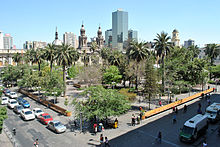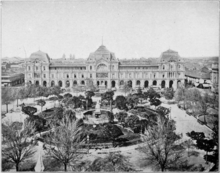
Santiago, also known as Santiago de Chile, is the capital and largest city of Chile and one of the largest cities in the Americas. It is located in the country's central valley and is the center of the Santiago Metropolitan Region, which has a population of seven million, representing 40% of Chile's total population. Most of the city is situated between 500–650 m (1,640–2,133 ft) above sea level.
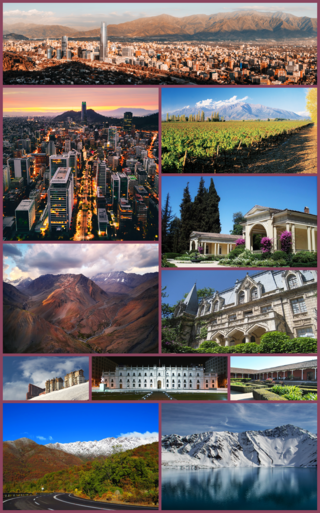
Santiago Metropolitan Region is one of Chile's 16 first-order administrative divisions. It is the country's only landlocked administrative region and contains the nation's capital, Santiago. Most commercial and administrative centers are located in the region, including Chile's main international airport, Arturo Merino Benítez International Airport.

Palacio de La Moneda, or simply La Moneda, is the seat of the president of the Republic of Chile. It also houses the offices of three cabinet ministers: Interior, General Secretariat of the Presidency, and General Secretariat of the Government. Located in downtown Santiago, it occupies an entire block in the Civic District, bordered by Moneda street to the north, Morandé street to the east, Alameda del Libertador Bernardo O'Higgins to the south, and Teatinos street to the west.
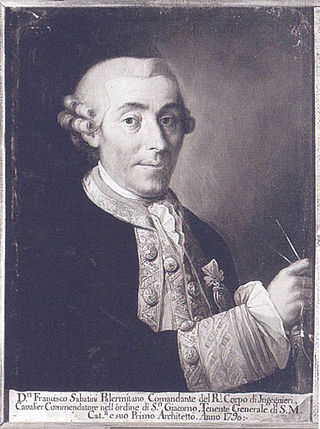
Gioacchino Toesca e Ricci was an Italian architect who worked at the service of the Spanish Empire, mainly in Chile. He was mainly a Neoclassical architect although he also built Baroque buildings.
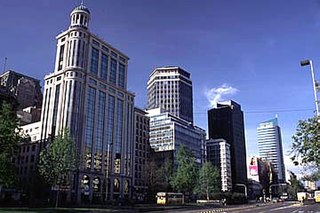
Avenida Libertador General Bernardo O'Higgins, popularly known as 'La Alameda', is the main avenue of Santiago, Chile. It runs east-west in the centre of the greater urban area and is 7.77 km (4.83 mi) long, and it has up to 5 lanes in each direction. It was named after Chile's founding father Bernardo O'Higgins. It was originally a branch of the Mapocho River.

The Chilean Museum of Pre-Columbian Art is an art museum dedicated to the study and display of pre-Columbian artworks and artifacts from Central and South America. The museum is located in the city centre of Santiago, the capital of Chile. The museum was founded by the Chilean architect and antiquities collector Sergio Larraín García-Moreno, who had sought premises for the display and preservation of his private collection of pre-Columbian artefacts acquired over the course of nearly fifty years. With the support of Santiago's municipal government at the time, García-Moreno secured the building and established the museum's curatorial institution. The museum first opened in December 1981.
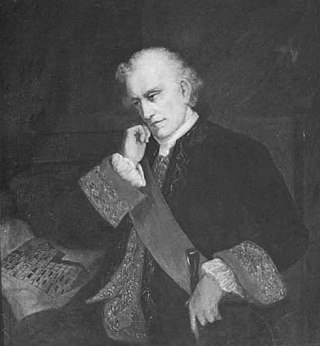
Ambrosio de Benavides Medina Liñán y Torres was a Spanish colonial administrator who served as Royal Governor of Puerto Rico, Royal Governor of Charcas and Royal Governor of Chile.

Santiago Metropolitan Cathedral is the seat of the Archdiocese of Santiago de Chile and the main temple of the Catholic Church in that country. As a Cathedral Church, it is the permanent seat of the Archbishop of Santiago and is dedicated to the Assumption of the Virgin Mary.

The Palacio de la Real Audiencia de Santiago is a building located in the north central village of the Plaza de Armas in Santiago, Chile. The building dates back to 1808 and houses, since 1982, the National History Museum of Chile.

The Central Post Office Building is a historic post office building on the northern edge of the Plaza de Armas, in Santiago, Chile. It is adjacent to the Palacio de la Real Audiencia de Santiago and is located on what was the land lot originally owned by Pedro de Valdivia and where he built his house. The site also was occupied by a building that served as Presidential Palace until 1846. Construction of the current building began in 1881 and was designed by Ricardo Brown. Its current appearance dates to 1908.
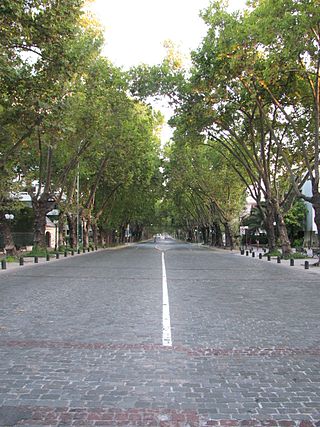
Pedro de Valdivia Avenue is a major north-south avenue on the east side of Santiago, Chile. It is named after Pedro de Valdivia and passes through the districts of Providencia, Ñuñoa and Macul.

The following is a timeline of the history of the city of Santiago, Santiago Province, Chile.

Inca rule in Chile was brief, it lasted from the 1470s to the 1530s when the Inca Empire was absorbed by Spain. The main settlements of the Inca Empire in Chile lay along the Aconcagua, Mapocho and Maipo rivers. Quillota in Aconcagua Valley was likely the Incas' foremost settlement. The bulk of the people conquered by the Incas in Central Chile were Diaguitas and part of the Promaucae. Incas appear to have distinguished between a "province of Chile" and a "province of Copayapo" neighboring it to the north. In Aconcagua Valley the Incas settled people from the areas of Arequipa and possibly also the Lake Titicaca.
Juan Garland, born as John Garland, was an Irish military engineer who served the Spanish Empire, and who directed many of the largest public works made in Colonial Chile.
Chilean architecture is influenced by the country's history, religious culture and unique climate. Chile was a former Spanish colony and its architectural style was therefore strongly influenced by Spanish design. Due to the unique geographical environment, Chilean architecture was also designed to accommodate these natural conditions. In particular, Chile's special geologic structure and resultant high incidence of earthquakes and tsunamis have led to Chilean architects becoming quite experienced in the application of structures and materials for earthquake-resistant structures and post-disaster reconstruction.
The Avenida Independencia is a major north-south thoroughfare in Santiago de Chile, running 8.1 km through the districts of Conchalí and Independencia, giving its name to the latter. The name comes from the fact that on February 13, 1817, following the Battle of Chacabuco, the Army of the Andes camped in the area known presently as Plaza Chacabuco, and moved along the road to make a triumphal entry into Santiago.

Tala Canta Ilabe was an Inca governor for a zone in Collasuyo, corresponding to the ayllu where Talagante is currently located, near Santiago de Chile. Quilicanta, the Inca governor of Collasuyo who was assassinated by Inés de Suárez, was also from the same panaka as Tala Canta IIabe.

The Plaza de Armas of Cusco is located in the city of Cusco, Peru. Located in the historic center of the city is the main public space of the town since before its Spanish foundation in 1534.
